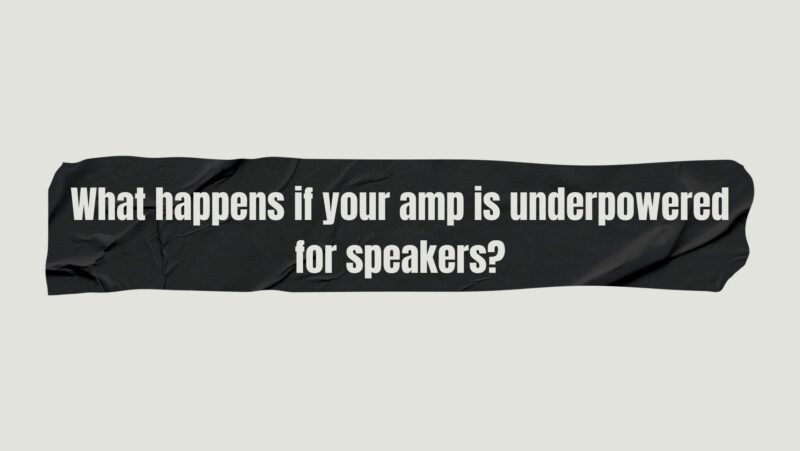In the realm of audio systems, achieving the perfect synergy between amplifiers and speakers is a critical consideration for optimal sound quality. However, a common concern that arises is what happens when an amplifier is underpowered for speakers. This scenario, where the amplifier’s output lacks the necessary power to drive the speakers effectively, can lead to various consequences that impact audio quality, speaker performance, and even the longevity of the components involved. In this comprehensive article, we delve into the intricacies of mismatched amplification, explore the potential effects on speakers, and provide insights into how users can navigate this challenge to ensure an enjoyable and sustainable audio experience.
Understanding Underpowered Amplification
Underpowered amplification occurs when the amplifier’s output power is insufficient to drive the speakers to their full potential. This scenario is marked by a disparity between the amplifier’s power rating and the power requirements of the connected speakers.
Effects on Audio Quality
- Distortion and Clipping: An underpowered amplifier struggles to produce the required output levels. As a result, the audio signal can become distorted and, in extreme cases, clipped. Distortion compromises audio fidelity and leads to an unnatural listening experience.
- Loss of Dynamics: Dynamics, which encompass the range between soft and loud sounds in music, are compromised when an amplifier lacks the power to accurately reproduce both ends of the spectrum. This results in a flattened and less engaging sound.
- Reduced Bass Response: Underpowered amplifiers may struggle to drive the lower frequencies, resulting in a weaker and less impactful bass response. This can lead to an unbalanced audio presentation.
Impact on Speaker Performance
- Heat Generation: An underpowered amplifier is more likely to enter into clipping, a state where the amplifier’s output waveform is cut off due to insufficient power. Clipping generates excessive heat that can damage both the amplifier and speakers.
- Stress on Speakers: In an attempt to compensate for the lack of power, an underpowered amplifier can drive speakers to their limits. This constant stress increases the risk of damaging speaker drivers and components.
- Tweeter Damage: High-frequency drivers, such as tweeters, are particularly susceptible to damage from clipping and distortion caused by underpowered amplification.
Potential Long-Term Consequences
- Component Degradation: Prolonged exposure to distorted or clipped signals can degrade speaker components, leading to reduced audio quality and compromised longevity.
- Reduced Speaker Lifespan: The constant strain placed on speakers by an underpowered amplifier can contribute to wear and tear, potentially shortening the lifespan of the speakers.
- Amplifier Overheating: The amplifier’s internal components can overheat due to constant clipping, potentially causing irreversible damage.
Choosing the Right Amplification
- Matching Power Ratings: Selecting an amplifier with a power rating that matches or slightly exceeds the speakers’ power requirements ensures a balanced and optimal audio setup.
- Sensitivity and Impedance: Understanding the sensitivity and impedance of speakers aids in choosing an amplifier that can deliver the required power for optimal performance.
Preventing Underpowered Amplification
- Amplifier Specifications: Pay close attention to amplifier specifications, including RMS and peak power ratings, to ensure they align with the speakers’ needs.
- Quality Amplifiers: Investing in high-quality amplifiers with clean power delivery reduces the risk of distortion and clipping, even when driven at higher volumes.
- Adding Subwoofers: Introducing subwoofers to the setup can alleviate the demand on main speakers, reducing the risk of underpowered performance in the low-frequency range.
Practical Listening Considerations
- Responsible Listening Levels: Avoid pushing the system to the point of distortion or clipping by maintaining reasonable listening levels.
- Room Acoustics: Recognize that room acoustics and size influence perceived loudness, potentially mitigating the need for excessive power.
Conclusion
Mismatched amplification, where an amplifier is underpowered for speakers, has far-reaching consequences that affect audio quality, speaker performance, and long-term durability. The effects include distortion, clipping, compromised dynamics, and potential damage to both amplifiers and speakers. To achieve the best audio experience and ensure the health of audio components, it’s essential to select amplifiers that match the power requirements of the connected speakers. By understanding the implications of underpowered amplification, users can make informed decisions, invest in quality amplification, and take steps to prevent the detrimental effects of mismatched audio setups. Striking the right balance between amplifier power and speaker needs leads to a harmonious audio system that delivers the intended musical experience while safeguarding the integrity of the components involved.


